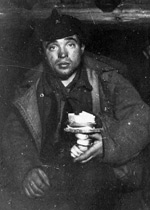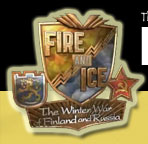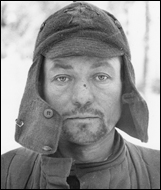

Both sides took POWs in the Winter War. Although after the peace treaty of Moscow in 1940 there was exchange of prisoners and most of them came back home. Life in prison camps in the Soviet Union and Finland was far from rosy.
Soviet soldiers that were taken prisoner in battle were quite often in very bad physical condition - frostbitten, starved and often wounded. As their political officers had told them, Finns would torture prisoners and then kill them – a stereotype probably based on the experiences of the Finnish Civil War when both Red Finns and White Finns showed no mercy to prisoners. The Finnish POWs had similar fears when they were taken prisoner.

A
Russian POW in a Finnish dugout in Summa, January 1940.
Bair Irincheev Collection
Neither Finland nor the Soviet Union had a policy of planned extermination of prisoners in the Winter War. Treatment in different camps varied but in most of the cases POWs were provided with basic means of survival.
Both Red Army and Finnish POWs were used for propaganda (writing and signing letters to their brothers-in-arms at the front, posing for photographs and so on). They were also subject to propaganda during their stay in POW camps. Finnish officers and former Russian Imperial Army officers in Finland tried to convince Soviet POWs of the advantages of life in the West. Soviet political officers tried to convince Finnish POWs of the advantages of the Soviet system.
The Finnish civilian population was evacuated from the border areas the Finnish Army considered endangered by the possible Soviet invasion, so in these areas the Red Army did not take civilian prisoners. In the areas north of Ladoga, and especially Suomussalmi, civilians were not evacuated. One reason was that civilians were scattered in their homes miles from each other, many were very close to the border and the Finnish Army just did not manage to send a message about the Soviet invasion. Another reason was that the Finnish Army did not expect any major Soviet attack in those areas.
These civilians were offered to join a commune in Soviet Karelia in order to assist building the Soviet Union. As living standards before the war in the northern areas of Finland were low, many Finns agreed to move to a labor camp on the Soviet side of the border. However, the whole affair was very badly organized by Soviet officials and the camp was very poorly supplied with food. Finnish workers started to starve and die from different diseases. Their illusions about life in the Soviet Union were also gone, but it was too late to turn back: they were about 200 miles away from home and there was no way one could walk that distance in winter conditions.
After the war the surviving Finns were turned back to Finland by the Soviet authorities. They were all tried by the Finnish government and some were sentenced for cooperation with the enemy.
Fate of the Soviet POWs after return home was also often tragic. They were tried and those, who were found guilty of state treason or cooperation with the enemy, were sentenced to long imprisonment terms in labor camps across Siberia. In order to be found not guilty, a former POW had to clearly explain how he was taken prisoner and prove that he did not surrender voluntarily, as according to the Soviet law of that time surrendering to the enemy was a crime.





